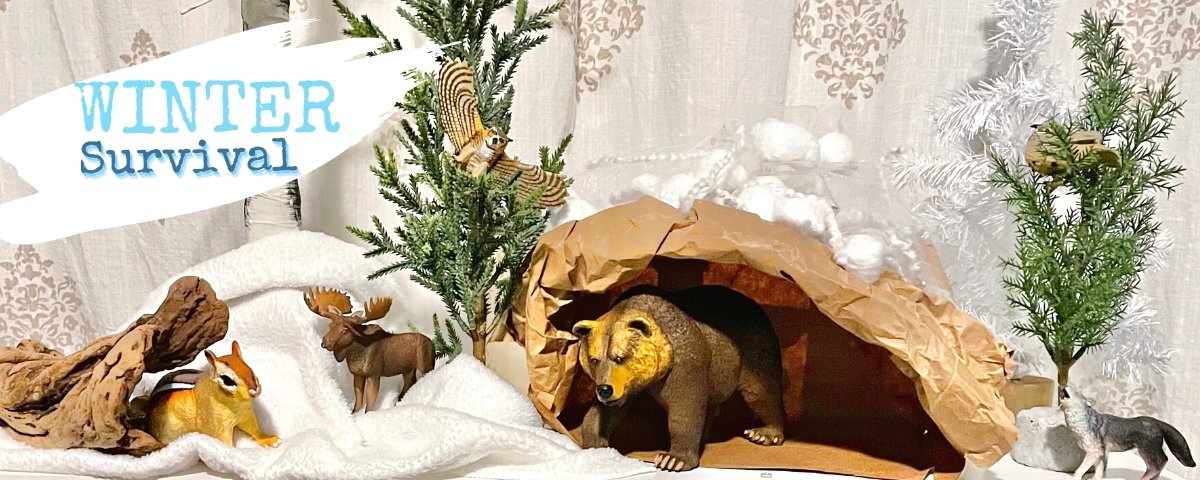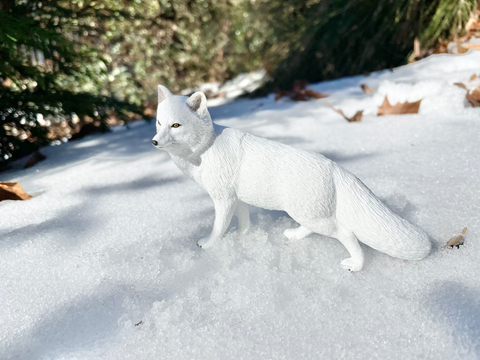Brrr…it’s cold outside! Just how do different animals survive the winter? When the cold weather sets in, some animals take to their beds and hibernate, some adapt, while others migrate and take a road trip to warmer climates. Let’s explore these three ways that wild animals use to stay safe and warm during the colder months.
Time for bed…
Have you ever heard of hibernation? It's a process that animals use to survive the cold winter months. But how do they do it and why?
When temperatures drop and food is scarce, some animals go into a period of dormancy. In hibernation, an animal's metabolism, body temperature, and heart rate drop dramatically. This helps them conserve energy and keep warm during the winter months. Bears are iconic hibernators, but did you know that there are MANY other animals that hibernate as well? Check out some of the other super sleepers:
- Bats
- Box Turtles
- Bumblebees
- Chipmunks
- Frogs
- Garter Snakes
- Groundhogs
- Hedgehogs
- Ladybugs
- Lizards
- Rodents
- Toads
Animals prepare for hibernation by eating large amounts of food in summer and fall (like bears and geckos) or by gathering food and building nests for themselves (like rodents). Other critters build special shelters underground to stay warm and dry during the winter months. One wild amphibian has an extreme way of hibernating; the wood frog freezes to survive! A portion of the water in their bodies freezes and they go into a state of suspended animation until spring.
Going on a journey…
In winter, temperatures drop and food often becomes scarce, so some animals travel to warmer areas where they can find plenty of food and shelter.
These seasonal migrations are another strategy used by wild animals to survive. Migration is a long journey that animals traverse from one location to another. It's like a big road trip, but over vast distances and for long periods. Most of us are familiar with the honking V-formations of geese in the fall; birds are famous for their long-distance migrations. They travel thousands of miles to reach their warmer destinations. Other migrating animals include caribou, monarch butterflies, whales, salmon, and turtles. Though not truly a migration, some humans choose to spend the winter months in the warmer southern parts of the USA and are playfully referred to as "snowbirds". :)
Migration patterns vary from species to species, but most migratory animals rely on their sense of smell, vision, and memory to navigate their way through unfamiliar terrain. Other migratory animals use the stars and the sun for guidance or rely on physical landmarks such as mountains or rivers. Migration also relies heavily on instinct; some animals mysteriously seem to know where to go without prior knowledge or training!
Migration is an incredible phenomenon that helps many animals survive during harsh winters. Next time you hear the honking of migrating geese or see monarch caterpillars dining on milkweed, be amazed at the wonderous animal journey you are witnessing!
It’s all in the outfit…
Whether special fur, blubber, or unique feet - the ability to adapt gives many wild animals an edge and the ability to withstand extreme temperatures.
Insulation matters! In colder regions, many animals have modified fur that helps insulate them from the cold and camouflages them in the snow. The arctic fox, wolves, and other animals have extra thick fur. The fur of the arctic fox gets up to 200 times thicker in winter. Polar bears have special outer hairs on their coat that reflect heat towards their black skin to be absorbed and help raise body temperature. Many mammals, like beavers and walruses, put on extra fat or have thick layers of blubber to maintain warmth.
Thick fur isn’t the only cold weather adaptation. When temperatures drop, birds fluff their feathers to trap pockets of warm air and preen to add waterproofing. They also sometimes roost and cuddle in cozy groups or find shelter to stay warm. The thick fur of an arctic hair or arctic fox changes from brown in warm months to white in the winter to blend in with the snow to keep them safe from other predators. Some arctic animals, like the arctic hair and caribou, have specialty feet that allow them to easily navigate over ice and snow.
So there you have it - three ways wild animals survive the winter season: hibernation, migration, and adaptations!
It's amazing how nature has created such clever ways for animals to protect themselves from the elements and find food during colder times of the year. Whether they're flying south or snuggling up in furry coats, each animal has a way of adapting to cold weather— isn’t nature just so COOL?! You can figure out some adaptions of your own, bundle up or travel, and adventure outside to have some fun observing wildlife this winter season. We hope you get the chance to spot some of these creatures using their unique survival tactics. Nature is truly incredible!
References:
Gates of the Arctic: National Park and Preserve Alaska, Biological Miracle, https://www.nps.gov/gaar/learn/nature/wood-frog-page-2.htm
Bering Land Bridge: National Preserve Alaska, Alaskan Animal Adaptations, https://www.nps.gov/bela/learn/kidsyouth/alaskan-animal-adaptations.htm
PBS Nature, Snowbound: Animals of Winter, https://www.pbs.org/wnet/nature/snowbound-animals-winter/14857/ , 1/11/2017
NH PBS Nature Works, How and Why Animals Migrate, https://nhpbs.org/natureworks/nwep4c.htm
National Geographic Learn With Us Resource Library, Nature’s Most Impressive Animal Migrations, https://education.nationalgeographic.org/resource/natures-most-impressive-animal-migrations






